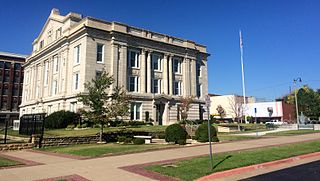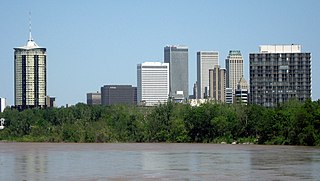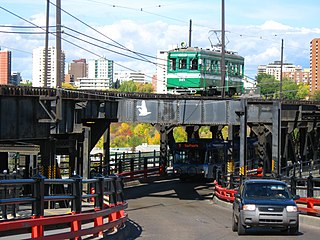Related Research Articles

Sapulpa is a city in Creek and Tulsa counties in the U.S. state of Oklahoma. The population was 20,544 at the 2010 United States census, compared to 19,166 at the 2000 census. The population as of 2022 is 22,205. As of 2019, the estimated population was 21,278. It is the county seat of Creek County.
Copan is a town in Washington County, Oklahoma, United States. The population was 733 at the 2010 census, a decline of 7.9 percent from the figure of 796 recorded in 2000.
Greenwood is a historic freedom colony in Tulsa, Oklahoma. As one of the most prominent concentrations of African-American businesses in the United States during the early 20th century, it was popularly known as America's "Black Wall Street". It was burned to the ground in the Tulsa race massacre of 1921, in which a local white mob gathered and attacked the area. Between 75 and 300 Americans were killed, hundreds more were injured, and the homes of 5000 were destroyed, leaving them homeless. The massacre was one of the largest in the history of U.S. race relations, destroying the once-thriving Greenwood community.
West Tulsa is a local name given to an area situated in the west section of the city of Tulsa, Oklahoma which includes various communities to the west and south of the Arkansas River. As development between Sand Springs and Tulsa continued in the late 19th through the early 20th centuries, the name West Tulsa was used to refer to this area west of Tulsa and north of the Arkansas River, but many people in Tulsa and those knowing of the history of Tulsa do not include this area near Sand Springs when referring to West Tulsa.
The title of "Oil Capital of the World" is often used to refer to Tulsa, Oklahoma. Houston, Texas, the current center of the oil industry, more frequently uses the sobriquet “The Energy Capital of the World.”
Oklahoma City is near the geographic center of the United States and is an integral point on the U.S. Interstate Network. The city is served by numerous roads and highways, toll roads, three major airports, a train station, a bus station, and a transit system.

The historic U.S. Route 66, sometimes known as the Will Rogers Highway after Oklahoma native Will Rogers, ran from west to northeast across the state of Oklahoma, along the path now taken by Interstate 40 (I-40) and State Highway 66 (SH-66). It passed through Oklahoma City, Tulsa, and many smaller communities. West of the Oklahoma City area, it has been largely replaced by I-40; the few independent portions that are still state-maintained are now I-40 Business. However, from Oklahoma City northeast to Kansas, the bypassing I-44 is mostly a toll road, and SH-66 remains as a free alternate.

Pittsburgh Railways was one of the predecessors of Pittsburgh Regional Transit. It had 666 PCC cars, the third largest fleet in North America. It had 68 streetcar routes, of which only three are used by the Port Authority as light rail routes. With the Port Authority's Transit Development Plan, many route names will be changed to its original, such as the 41D Brookline becoming the 39 Brookline. Many of the streetcar routes have been remembered in the route names of many Port Authority buses.

Tulsa is the second-largest city in the state of Oklahoma. It has many diverse neighborhoods due to its size.

The Third Avenue Railway System (TARS), founded 1852, was a streetcar system serving the New York City boroughs of Manhattan and the Bronx along with lower Westchester County. For a brief period of time, TARS also operated the Steinway Lines in Long Island City.

Transportation in Tulsa, Oklahoma includes a bus network and a system of raised highways and primary thoroughfares, laid out in mile-by-mile increments. In addition, throughout its entire length in Tulsa, historic Route 66 is a drivable road, with motels and restaurants reminiscent of the route's heyday era.

Central High School is the oldest high school in Tulsa, Oklahoma. It was founded in 1906 as Tulsa High School, and located in downtown Tulsa until 1976. The school now has a 47-acre (19 ha) campus in northwest Tulsa. Tulsa Central is part of the Tulsa Public Schools, Oklahoma's largest school district, and is a public school for students from grades 9 through 12. Since 1997 it has served as a fine and performing arts magnet school.

The High Level Bridge Streetcar is a historic streetcar ride over the High Level Bridge in Edmonton, Alberta. It travels from the Strathcona Streetcar Barn & Museum, just north of the Strathcona Farmers Market, in Old Strathcona, to Jasper Plaza south of Jasper Avenue, between 109 Street and 110 Street, in downtown, with three intermediate stops. It operates between the Victoria Day weekend in May, and Thanksgiving weekend in October. It is operated by the Edmonton Radial Railway Society, which operates five more streetcars on a second line in the river valley at Fort Edmonton Park.
Spartan College of Aeronautics and Technology (Spartan) is a private for-profit aviation college in Tulsa, Oklahoma. It was originally established to provide pilot and technicians for Spartan Aircraft Company but outlived its parent company and continues to train pilots and mechanics into the 21st Century. The main campus is adjacent to Tulsa International Airport, with another campus used for flight training at Richard Lloyd Jones Jr. Airport.

The First Presbyterian Church of Tulsa was organized in 1885 in Creek Nation, Indian Territory, before statehood. It originally met in the store owned by brothers James M. Hall and Harry C. Hall, and was served by itinerant, circuit-riding ministers.
The following is a timeline of the history of the city of Tulsa, Oklahoma, United States.

The Creek Council Oak Tree is a historic landmark which represents the founding of the modern city of Tulsa, Oklahoma, United States by the Lochapoka Tribal Town of the Creek Nation.

Public transit has taken numerous forms in Columbus, the largest city and capital of Ohio. Transit has variously used passenger trains, horsecars, streetcars, interurbans, trolley coaches, and buses. Current service is through the Central Ohio Transit Authority's bus system, numerous intercity bus companies, and through bikeshare, rideshare, and electric scooter services.
References
- ↑ Cincinnati Hill Strava, retrieved 21 November 2013.
- ↑ "Order No. 742", Seventh Annual report of the Corporation Commission of the State of Oklahoma for the year ending 30 June 1914, Oklahoma City, 1914.